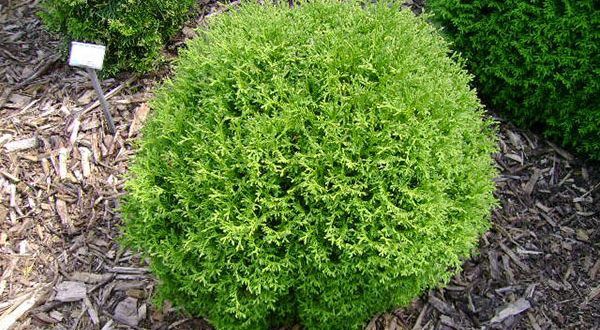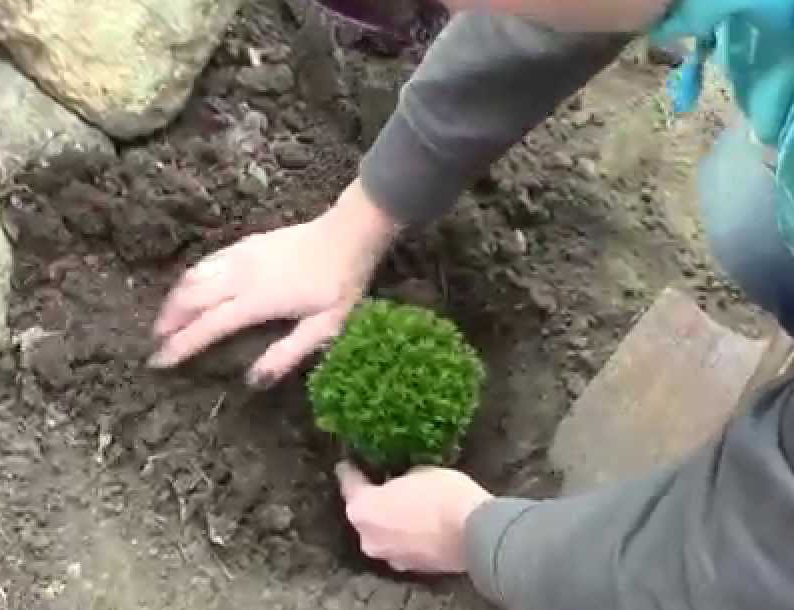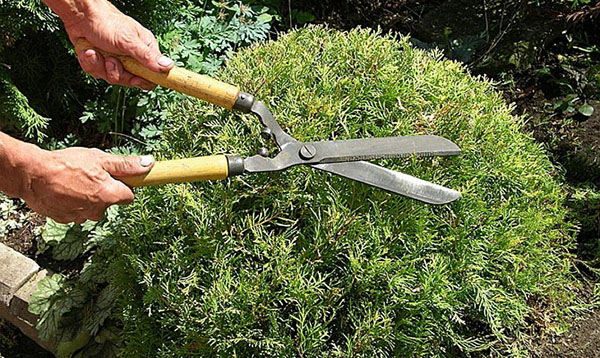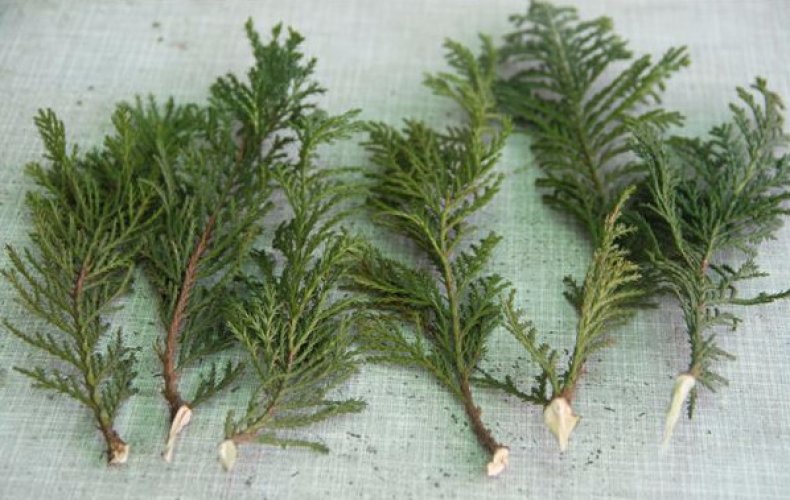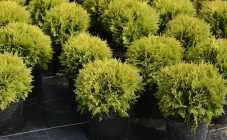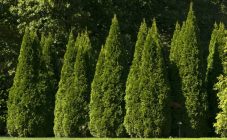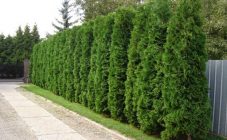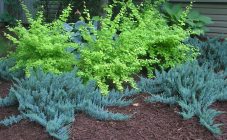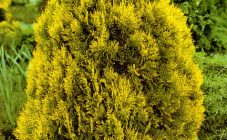Content:
An ornamental plant for the garden - thuja Teddy, is in great demand among Russian gardeners. A small spherical evergreen bush attracts attention, allows you to decorate the garden area. Unpretentiousness in planting and care makes it possible for novice gardeners to propagate thuja on their own.
History
The plant is considered the homeland of the eastern part of North America. For the first time the description of thuja was made by Karl Linnaeus in 1753. The name of the plant is translated from Greek as "incense". This is due to the aromatic haze that comes from burning the bark and branches of the tree. Tuy Teddy is also called juniper Teddy or "life tree".
Plant characteristic
Thuja Teddy belongs to the Cypress family. The plant is spherical, small in height. An adult shrub grows on average up to 1 m. A coniferous dwarf evergreen plant is used in landscape design. Thuja emits aromatic essential oils that purify the air, fill it with a pleasant scent of pine needles.
The culture is considered unpretentious, takes root well on any type of soil, grows well in different climatic zones.
The color of the needle-shaped foliage is bluish-green; in the fall, the crown acquires a bronze tint. The shoots are completely covered with soft needles, so the bush resembles a ball. In winter, part of the foliage falls off; in 2-3 years, a complete change of leaves occurs.
Description of Tui Teddy
Thuja western Teddy description:
- Thuja is a slow-growing coniferous bush. In 1 year, the tree grows by about 2-3 cm;
- The color of the plant can be deep green with a bluish tint;
- Shoots are located tightly to each other;
- A perennial tree has smooth bark;
- Branched roots, located close to the ground surface;
- The needle-shaped leaves are soft to the touch;
- Cones are small in size, they have many thin scales;
- Thuja can be planted in open ground or in garden pots;
- The crown grows in a spherical shape (diameter - 0.3-0.4 m) and does not require additional pruning;
- The plant produces essential oils with a pleasant pine scent, which purify the air.
Agricultural rules
The shrub belongs to unpretentious crops, but in order for the thuja to grow well and decorate the garden for many years, it is necessary to choose the right place for planting and follow the recommendations for planting and caring for the plant.
Tips for choosing a place to plant a thuja Teddy:
- Thuja is a sun-loving plant, therefore, the site should be even, well-lit, light partial shade is allowed. The best option is a sunny area, but without direct sunlight on hot days. If you plant a plant in the shaded side of the garden, then the thuja will grow more slowly, the crown will not turn out lush;
- It is necessary to take into account the wind rose. The area where thuja grows should not be windy, you should choose a place without drafts;
- The plant grows in almost all types of soil. Thuja grows actively on loose, moderately moist, fertile soils;
- Moisture stagnation should not be allowed. Thuja roots are superficial, with excessive moisture they can rot.Therefore, the site can be made slightly elevated so that excess water flows down.
The time for planting the plants is chosen, depending on the seedlings and the climatic characteristics of the region. If seedlings with closed roots have been purchased, then they can be planted from mid-spring to mid-autumn. It is recommended to plant seedlings with an open root system between May and September.
Tuya Teddy instructions for planting and care in the open field:
- Prepare a nutritious soil mixture. To do this, mix leafy earth, sand, peat in equal proportions;
- The site is recommended to be fertilized with mineral fertilizers;
- If the thuja Teddy with a closed root system, then the ground must be pre-moistened in order to easily remove the seedling along with the soil;
- Prepare the required number of holes. The size of the hole should be 2 times the size of the seedling;
- Place a drainage layer on the bottom of the fossa. Expanded clay, gravel, broken brick can be used as drainage. It is recommended to make a drainage layer at least 20 cm;
- After the drainage layer, the soil mixture prepared in advance is laid out. Put the nutritious soil on 2/3 of the hole. If the site was not previously fertilized, then organic or complex mineral fertilizers are additionally used to feed the soil;
- Pour warm water over the hole;
- Remove the seedling, place in the center of the hole. The root collar should be at ground level. Sprinkle the empty space with earth, tamp it with your feet, pour water over the hole;
- Sprinkle the soil around the trunk of the seedling with a layer of mulch (dry grass or sawdust). Mulch maintains an optimal level of soil moisture and does not allow weeds to grow;
- It is recommended to make the distance between juniper bushes 50-60 cm.
How to care for thuja Teddy
The gardener will not need much time and effort to devote to thuja. The plant grows well on its own; it is enough to perform standard shrub care manipulations.
Agrotechnical techniques for caring for thuja:
- Watering. The first 3 weeks after planting, the plant needs regular watering for better adaptation in a new place. Water a young seedling as the soil dries up. After the shrub has taken root, it will be enough to water once a week. 1 bush will require 2 buckets of water. If the summer is dry, the amount of watering increases. The procedure must be performed every 2-3 days. With a lack of moisture, the thuja crown begins to fade and turn yellow. So that a pleasant coniferous aroma emanates from the crown, you can water it by sprinkling. The water should not be cold. Watering is carried out in the morning or evening;
- Mulching. So that the earth does not dry out and a crust does not form, the hole must be mulched. Mulch serves as protection against drying out, overgrowth of weeds, maintains the soil microclimate;
- Loosening. If the hole is not mulched, then for good growth of thuja, regular loosening of the earth will be required after each watering. The roots of the plant are superficial, so the gardening tool is buried shallowly so as not to damage the roots;
- Top dressing. For the normal development of thuja, one feeding per year is enough. Fertilizers are recommended to be applied to the soil in April or May. It is better to use complex mineral fertilizers intended for conifers (Nutrisol). After loosening, peat or plant compost can be added;
- Pruning. Thuja does not need formative pruning, the crown itself grows in the shape of a ball. Sanitary pruning is carried out in the spring. It is enough to remove damaged dry branches;
- Shelter for the winter. Frost resistance in an adult thuja bush is high. The plant tolerates cold winters well and is adapted for growing in regions with different climates. It is recommended to cover a young plant aged 1 to 3 years. For shelter, a special agrofibre is used. Sprinkle the earth with a layer of mulch.
Thuja can be propagated by generative and vegetative methods. If you are planning a seed propagation method, then you will need to be patient, since the process of growing a full-fledged seedling from seeds takes a lot of time. When thuja is propagated by seeds, often a young plant will not inherit the maternal varietal traits.
In addition to these methods, thuja propagation is used by rooting horizontal layers, dividing the bush. These methods require certain skills and are suitable for experienced gardeners.
Diseases and pests
Thuja Teddy refers to plants that are rarely exposed to various diseases and attacks of pests.
Possible thuja diseases:
- Cytosporosis;
- Fusarium;
- Brown shute;
- Rust;
- Thuya pseudopod.
When the first signs of fungal diseases appear, the thuja must be treated with copper-containing preparations:
- Topsin-M (20 g / 10 l of water);
- Hom (40 g / 10 l of water).
For the prevention of diseases, it is recommended to use Bordeaux liquid or foundationol.
Landscape
For decoration of a garden plot, parks, squares, thuja Teddy will be an ideal option. The dwarf coniferous plant was bred specifically for decorative purposes. It is unpretentious to care for, independently forms a beautiful spherical crown, and is almost not attacked by pests and diseases.
For growing in the garden, you can use flower pots or containers of the required color and shape, which are displayed next to gazebos and terraces. The bushes will harmoniously fit into any corner of the garden area. Tuyu is planted in group or single plantings.
Growing thuja will not take a lot of time from the gardener. The exotic look of the plant will delight for many years with a neat green bush in the garden.
